Durst F. Fluid Mechanics: An Introduction to the Theory of Fluid Flows
Подождите немного. Документ загружается.

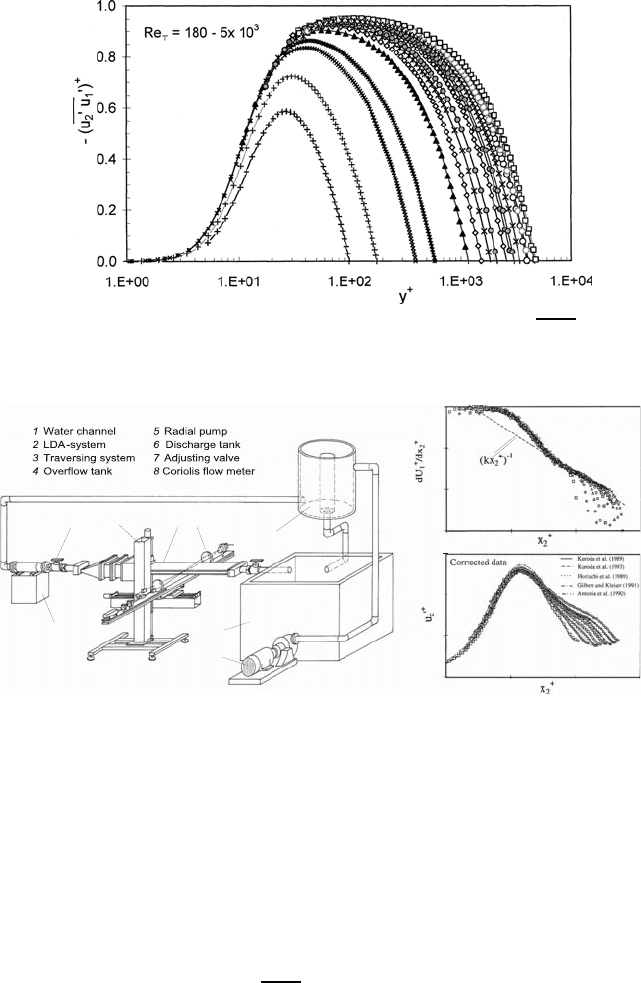
18.8 Turbulent Wall Boundary Layers 583
Fig. 18.24 Standardized turbulent momentum transport terms (u
1
u
2
) for plane
channel flows
7
3
12
4
6
5
8
1
1
0
10
2
3
100 1000
1
10
100 1000
0.001
0.01
0.1
1
Fig. 18.25 Plane channel flow and LDA system. Measurement results for
standardized turbulent velocity fluctuations in the flow direction
values obtained by numerical investigations, a general trend exists. The re-
maining discrepancies between the experimental and numerical data can, in
all probability, be attributed to mistakes in the numerical computations, as
the computed values were not subjected to corrections concerning the finite
numerical grid spacings employed.
The investigations described above are limited to such wall roughnesses
for which it holds that
δ
s
u
τ
ν
≤ =2.72, (18.246)
i.e. the values κ =1/e and B =10/e are valid only for flows with high
Reynolds numbers and for walls which can be considered to be hydraulically
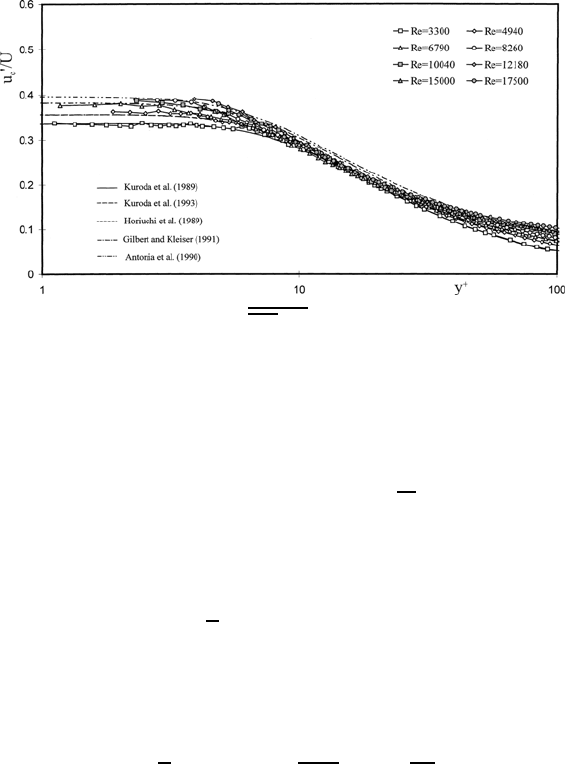
584 18 Turbulent Flows
Fig. 18.26 Turbulence intensity
u
1
2
/U
1
near the wall as a function of the
Reynolds number
smooth. For rough walls, an amendment proves necessary for which the
following considerations hold:
U
1
= f(y, ρ, µ, τ
w
,δ
s
) ; U
+
1
= f
y
δ
s
, (18.247)
where δ
s
represents the “sand roughness” of the wall. Similarity considera-
tions show that the following logarithmic wall law for rough channel walls
can be derived:
U
+
1
=
1
κ
ln y
+
+ B −∆B
!
δ
+
s
"
. (18.248)
Of particular interest is that point in the viscosity-controlled sub-layer of the
flow where the sub-layer U
+
1
= y
+
and the layer U
+
1
=1/κ(ln y
+
)havethe
same values and the same gradients:
U
+
1
= y
+
=
1
κ
ln y
+
and
dU
+
1
dy
+
=1=
1
y
+
. (18.249)
From this it follows that at y
+
= e this consideration is fulfilled for κ =1/e,
a value that also resulted from the measurements at LSTM, Erlangen. For
the logarithmic velocity profile with maximum roughness δ
+
s
for which a vis-
cosity dominated sub-layer still exists, it results that ∆B(δ
+
s
)=B =10/e,
see Fig. 18.27. With this, we can see that a constant representation of the
normalized velocity distributions for hydromechanically smooth and rough
channel walls can be presented. Nevertheless, many questions concerning de-
tailed problems of turbulent wall boundary layers have still to be answered
and need to be investigated with the help of modern measuring and com-
putation techniques. It is especially necessary to extend the results obtained
here for fully developed, two-dimensional, plane, turbulent channel flows to
pipe flows, and also to flat plate flows and turbulent film flows.
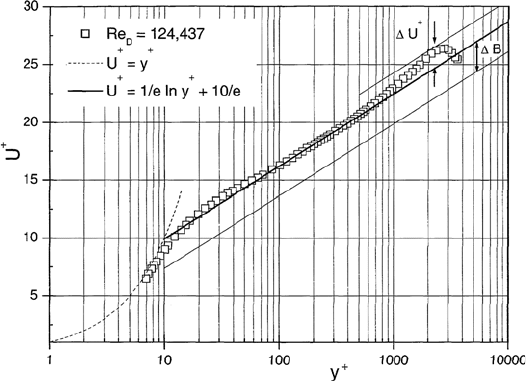
References 585
Fig. 18.27 Modification of the additive constants of the logarithmic wall law due to
roughness
References
18.1. Arpaci, V. S., Larsen, P. S.: “Convection Heat Transfer”, Central Book
Company, Taipei, Taiwan (1984)
18.2. Biswas, G., Eswaran, V.: “Turbulent Flows, Fundamentals, Experiments and
Modeling”, IIT Kanpur Series of Advanced Texts, Narosa Publishing House,
New Delhi (2002)
18.3. Hinze, J. O.: “Turbulence”, 2nd edition, McGraw-Hill, New York (1975)
18.4. Pope, S. B.: “Turbulent Flows”, Cambridge University Press, 2002
18.5. Schlichting, H.: “Boundary Layer Theory”, McGraw-Hill, New York (1979)
18.6. Tennekes, H., Lumley, J. L.: “A first Course in Turbulence”, MIT Press,
Cambridge, Mass., USA, (1972)
18.7. Townsend A. A.: “The Structure of Turbulent Shear Flows”, 2nd edition,
Cambridge University Press, Cambridge, UK (1976)
18.8. White, F. M.: “Viscous Fluid Flow”, Kingsport Press, Kingsport (1982)
18.9. Wilcox, D. C.: “Turbulence Modeling for CFD”, DCW Industries, La Canada
(1993)

Chapter 19
Numerical Solutions
of the Basic Equations
∗
19.1 General Considerations
The considerations in Chaps. 13–16 showed that analytical solutions of the
basic equations of fluid mechanics can often only be obtained when simpli-
fied equations or fully developed flows and small or large Reynolds numbers,
respectively, are considered and if, in addition, one limits oneself to flow
problems which are characterized by simple boundary conditions. Even with
these simplifications, the derivations carried out did not result in analytical
solutions for all flow problems to be solved, but merely reduced the flow de-
scribing partial differential equations to ordinary differential equations. As
shown in the previous chapters, the latter could be solved by means of cur-
rent analytical methods. Moreover, the boundary conditions characterizing
the flow problems could also be implemented into these solutions. Thus it was
demonstrated that the methods known in applied mathematics for solving or-
dinary differential equations represent an important tool for the theoretically
working fluid mechanics researcher. Although analytical techniques for the
solution of flow problems no longer have the significance they had in the
past, it is part of a good education in fluid mechanics to teach these methods
to students and for the latter to learn them.
When considering the partial differential equations discussed in the
preceding chapters, they can all be brought into the subsequent general form
A
∂
2
Φ
∂x
2
+2B
∂
2
Φ
∂x∂y
+ C
∂
2
Φ
∂y
2
+ D
∂Φ
∂x
+ E
∂Φ
∂y
+ FΦ = g(x, y). (19.1)
When designating as the discriminant of the differential equation (19.1)
d :=AC − B
2
(19.2)
∗
Important contributions to this chapter were made by my son Dr. -Ing. Bodo
Durst.
587

588 19 Numerical Solutions of the Basic Equations
one defines the differential equation as parabolic, hyperbolic or elliptic when
for d the following holds:
Parabolic differential equation: d = 0 (one-parameter characteristics),
Hyperbolic differential equation: d<0 (two-parameter characteristics),
Elliptic differential equation: d>0 (no real characteristics).
This classification of the differential equation orients itself by the equations
for parabolas, hyperbolas and ellipses of the field of plane geometry, in which
the equation:
ax
2
+2bxy + cy
2
+ dx + ey + f = 0 (19.3)
describes parabolas (ac − b
2
= 0), hyperbolas (ac − b
2
< 0) and ellipses
(ac − b
2
> 0). Accordingly, for the differential equations discussed in the
preceding chapters, one can characterize:
Diffusion equation
∂U
∂t
= ν
∂
2
U
∂x
2
, i.e. it holds A = ν, B = C =0and
thus d = 0. The diffusion equation has “parabolic
properties.”
Wave equation
∂
2
U
∂t
2
= c
2
∂
2
U
∂x
2
, i.e. it holds A = c
2
, B =0,C =
−1 and thus d = −c
2
< 0. The wave equation is
hyperbolic.
Potential equation
∂
2
Φ
∂x
2
+
∂
2
Φ
∂y
2
= 0, i.e. A = C =1,B =0andthusd>0.
The potential equation shows “elliptical behavior.”
The stationary boundary-layer equations are, as can be demonstrated
when analyzing them according to the above representations, parabolic differ-
ential equations. Such equations have a property which is important for the
numerical solution to be treated in this section. The solution of the differen-
tial equation determined at a certain point of a flow field, does not depend on
the boundary conditions that lie downstream. This makes it possible to find
a solution for the entire flow field via “forward integration,” i.e. the solution
can be computed in a certain level of the flow field alone from the values of
the preceding level. This is characteristic for parabolic differential equations
which thus, in the case of numerical integration, possess advantages which
the elliptic differential equations do not have. This becomes clear when look-
ing at Fig. 19.1, which shows which subdomain of a flow field acts on the
properties at a point P , i.e. determines its flow properties.
In order to be able to solve differential equations numerically, it is necessary
to cover the flow region with a “numerical grid,” as e.g. indicated in Fig. 19.2
for a special flow problem, where a structured grid is shown. This is installed
over a plane plate which carries out the following motion:
U
1
(x
2
=0,t< 0) = 0 The plate rests for all times t<0,
U
1
(x
2
=0,t≥ 0) = U
0
The plate moves at constant velocity for t ≥ 0.
By the motion of the plate, the fluid above the plate is, due to the molecular
momentum transport, set in motion.
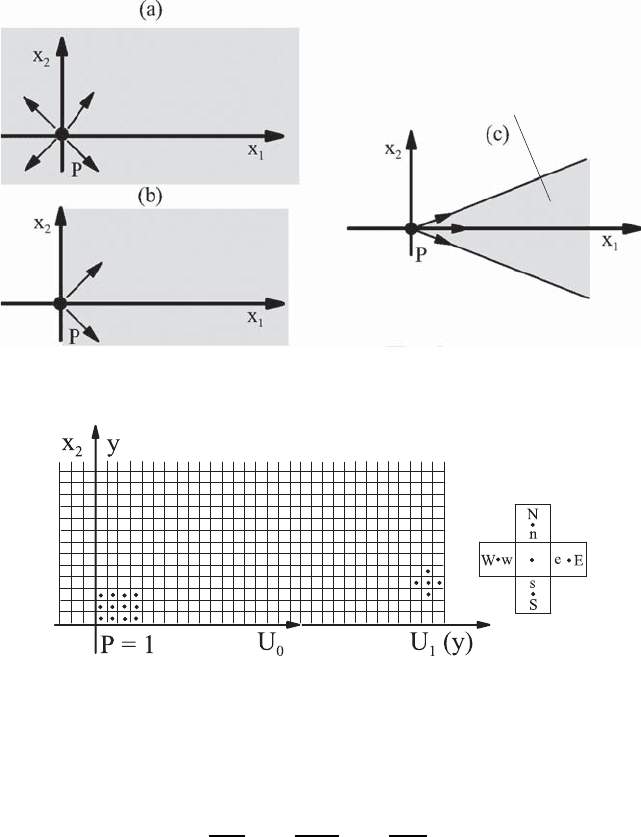
19.1 General Considerations 589
Region of influence of
elliptic diff. equation
Region of influence of
parabolic diff. equation
Region of influence of
hyperbolic diff. equation
Fig. 19.1 Regions of influence for properties in point P for elliptic (a), parabolic (b)
and hyperbolic (c) differential equations
Fig. 19.2 Numerical grid for computing the fluid motion for sudden motion of the
plate
The momentum input into the fluid is, assuming an infinitely long plate
in the x
1
direction, described by the following differential equation:
∂U
1
∂t
= ν
∂
2
U
1
∂x
2
2
= ν
∂
2
U
∂y
2
. (19.4)
To be able to describe the solution of this differential equation on the numer-
ical grid of Fig. 19.2, discretizations of the first derivative in time and second
derivative in space in the differential equation (19.4) are necessary. An anal-
ysis of the differential equation shows that the discriminant is d = 0, i.e. the
differential equation is parabolic. The solution concerning time t can thus be
computed from the solution concerning time t − ∆t. Inversely it holds, how-
ever, that the solution concerning time (t + ∆t) cannot be used to compute
the solution concerning time t. When using the “finite-difference method” for
discretization (see Sect. 19.3), for the time a forward-difference formulation

590 19 Numerical Solutions of the Basic Equations
and for y a central-difference formulation can be employed, from which the
following finite-difference equation for the differential equation (19.4) results:
U
α+1
β
− U
α
β
∆t
= ν
3
U
α
β+1
− 2U
α
β
+ U
α
β−1
(∆y)
2
4
. (19.5)
With this the velocity U in the time interval (α + 1) can be computed
explicitly:
U
α+1
β
= U
α
β
−
ν∆t
(∆y)
2
!
U
α
β+1
− 2U
α
β
+ U
α
β−1
"
, (19.6)
i.e. a discrete solution of the differential equation is possible. The discretized
equation is defined as consistent when for the transition ∆y → 0and∆t → 0
(19.6) turns into the original differential equation (19.4). Here, checking of the
consistency can be done through an analysis treating the truncation error.
When for ∆y and ∆t → 0 the truncation error heads towards zero, the
employed differentiation method is consistent.
For the reasonable application of numerical computation methods, it is
moreover necessary that the “discretization method used is stable,” i.e. yields
stable solutions. The required stability is generally guaranteed when perturba-
tions introduced into the solution process are attenuated by the discretization
method. However, when an excitation of occurring perturbations takes place,
the chosen discretization method is defined as unstable. With respect to
fluid-mechanical problems, for stability considerations of the solution meth-
ods employed, the diffusion number Di and the Courant number Co are of
importance:
Di =
ν∆t
(∆y)
2
and Co =
U∆t
∆y
. (19.7)
Here, the diffusion number indicates the ratio of the time interval ∆t cho-
sen in the discretization to the diffusion time (∆y
2
)/ν, while the Courant
number states the ratio of the chosen time interval ∆t to the convection
time (∆y/U ). It is understandable that the numerical computation method
can provide stable solutions only when the chosen time intervals ∆t can re-
solve the physically occurring diffusion and convection times in the chosen
numerical grid. Details are explained in the subsequent paragraphs.
It is also important for a chosen discretization method that the conver-
gence of the solution is guaranteed. This means that the numerical solution,
with continuous improvements of the numerical grid, agrees more and more
with the exact solution of the differential equation. Yet the “Lax equiva-
lence theorem” says that stable and consistently formulated discretizations
of linear initial-value problems lead to convergent solutions, i.e. at least for
linear differential equations, it can be shown that the consistency, stability
and convergence of discretization methods are closely linked properties of a
discretization method employed for the solution of differential equations. In
the case of existing consistency, it is sufficient for a discretization method to
prove its stability, in order to be able to predict reliably its convergence also.
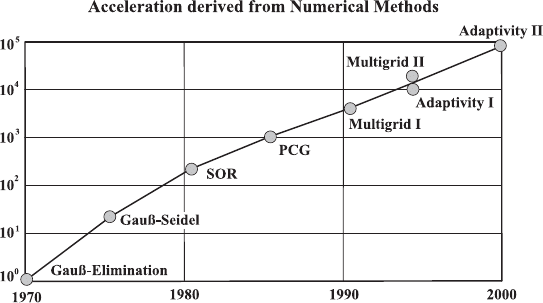
19.2 General Transport Equation and Discretization 591
Fig. 19.3 Increase in performance of mathematical methods for solving basic equa-
tions in fluid mechanics
As far as numerical solutions of the basic equations of fluid mechanics are
concerned, their solution regarding engineering problems is connected to high
computational efforts. By efficient numerical computational methods and the
employment of the currently available high computer power, this can nowa-
days be managed. Developments in applied mathematics have contributed to
this (see Fig. 19.3) and have led to a continuous increase in the performance
of computational methods for numerical solutions of the basic equations of
fluid mechanics. Figure 19.3 shows the increase in performance of numerical
computational methods, which has led, on average, to a tenfold increase ev-
ery 8 years. Combining this with the increase in computational power, which
can be said to have had a tenfold increase every 5 years (see Fig. 19.4), it
becomes understandable why numerical fluid mechanics has been gaining in-
creased significance in recent years. It is the field of numerical fluid mechanics
to which the greatest importance has to be attached in the near future. The
above increases in computing and computer power have significance with re-
gard to solutions of engineering fluid flow problems. It is therefore imperative
that modern fluid-mechanical education has an emphasis on numerical fluid
mechanics. In this chapter, only an introduction to this important field can
be given. These are detailed treatments of numerical fluid mechanics given
in refs. [19.1] to [19.6].
19.2 General Transport Equation and Discretization
of the Solution Region
In Chap. 5, the basic equations of fluid mechanics were derived and stated in
the form indicated below:
• Continuity equation:
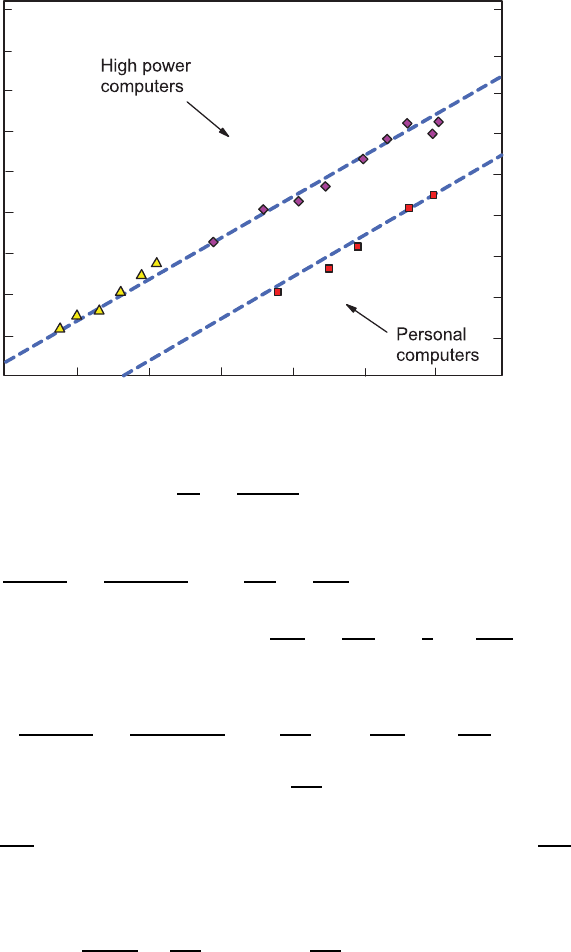
592 19 Numerical Solutions of the Basic Equations
10
10
10
10
10
10
10
10
0
2
4
6
8
10
12
14
1940
1950
1970
1960 1980
1990
2000
Univac 1101
IBM 704
Univac Larc
IBM 7030
CDC 7600
Cray - 1S
Cray -2s/4-128
NEC SX -3/44
Intel ASCI Red
8068/87
80386/87
80486
Pentium Pro
16
18
10
10
2010
AMD K7/600
IBM 701
EDSAC
CYBER205
IntelXP/S140
NEC SX-5/16
Hitachi SR800-F1
Development of computer power (Flop/s)
Fig. 19.4 Increase in the performance of high-speed computers and of personal
computers
∂ρ
∂t
+
∂ (ρU
i
)
∂x
i
=0. (19.8)
• Navier–Stokes equation:
∂ (ρU
j
)
∂t
+
∂ (ρU
i
U
j
)
∂x
i
= −
∂P
∂x
j
−
∂τ
ij
∂x
i
+ ρg
j
(19.9)
τ
ij
= − µ
∂U
j
∂x
i
−
∂U
i
∂x
j
+
2
3
µδ
ij
∂U
k
∂x
k
.
• Energy equation:
∂ (ρc
v
T )
∂t
+
∂ (ρc
v
U
i
T )
∂x
i
= −
∂q
i
∂x
i
− τ
ij
∂U
j
∂x
i
− P
∂U
i
∂x
i
, (19.10)
q
i
= − λ
∂T
∂x
i
,
where τ
ij
∂U
j
∂x
i
, in the last equation, represents the dissipation and P
∂U
i
∂x
i
the work done during expansion. These equations can be transferred into a
general transport equation in such a way that the following equation holds:
∂ (ρΦ)
∂t
+
∂
∂x
i
ρU
i
Φ − Γ
∂Φ
∂x
i
= S
Φ
, (19.11)
where Φ and S
Φ
for the different equations are indicated in Table 19.1
Considerations on the numerical solution of the basic equations of fluid
mechanics can thus be restricted to equations of the form indicated in (19.11).
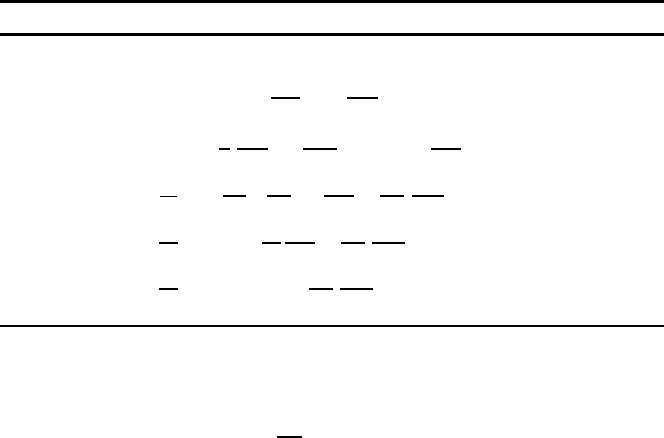
19.2 General Transport Equation and Discretization 593
Table 19.1 Φ, Γ and S
Φ
values for the general transport equation
Equation ΦΓ S Remarks
Continuity 1 0 0 –
Momentum u
j
µ
∂
∂x
i
µ
∂U
i
∂x
j
Newtonian fluid and
compressible flow
−
2
3
∂
∂x
j
µ
∂U
k
∂x
k
+ g
j
ρ −
∂P
∂x
j
Energy T
λ
c
p
ρT
c
p
∂ν
∂T
p
DP
Dt
−
τ
ij
c
p
∂U
j
∂x
i
–
T
λ
c
p
1
c
p
DP
Dt
−
τ
ij
c
p
∂U
j
∂x
i
Ideal gas
T
λ
c
p
−
τ
ij
c
p
∂U
j
∂x
i
Incompressible or
isobaric
The latter comprises a relationship which indicates the variations in terms of
time of (ρΦ) and changes in space in the form of a convection term (ρU
i
Φ)
and also a diffusion term (−Γ
∂Φ
∂x
i
). In the source term S,allthoseterms
of the considered basic equations are contained that cannot be placed in the
general convection and diffusion terms.
With the general transport equation (19.11), a constant description in
terms of time and space is available of all the physical laws to which fluid
motions are subjected. However, the numerical solution of the transport
equation requires a discretization of the equation with respect to time and
space. Thus, through the numerical solutions of flow problems, solutions are
sought only of the flow quantities at determined points in space, which are
arranged at distances of ∆x
i
. The determination of these points, before start-
ing a numerical solution of a flow problem, is defined as grid generation, i.e.
the entire flow region is subdivided into discrete subdomains. In general, it
is usual to do the subdivision already in such a way that certain advan-
tages result for the sought numerical solution method. Regular (structured)
and irregular (unstructured) grids can, in principle, be employed; experi-
ence shows, however, that the efficiency of numerical solution algorithms is
influenced particularly disadvantageously by the irregularity of the numeri-
cal grid. On the other hand, it holds that in the presence of complex flow
boundaries the grid generation is considerably facilitated by unstructured
grids. Geometrically complex boundaries of flow regions can be introduced
more easily into the numerical computations to be carried out via unstruc-
tured grids. With this, in the case of strongly irregular grids, triangles,
quadrangles, tetrahedrons, hexahedrons, prisms, etc., can be employed in
combination.
Structured grids are characterized by the general property that the neigh-
boring points surrounding a considered grid point correspond to a firm
